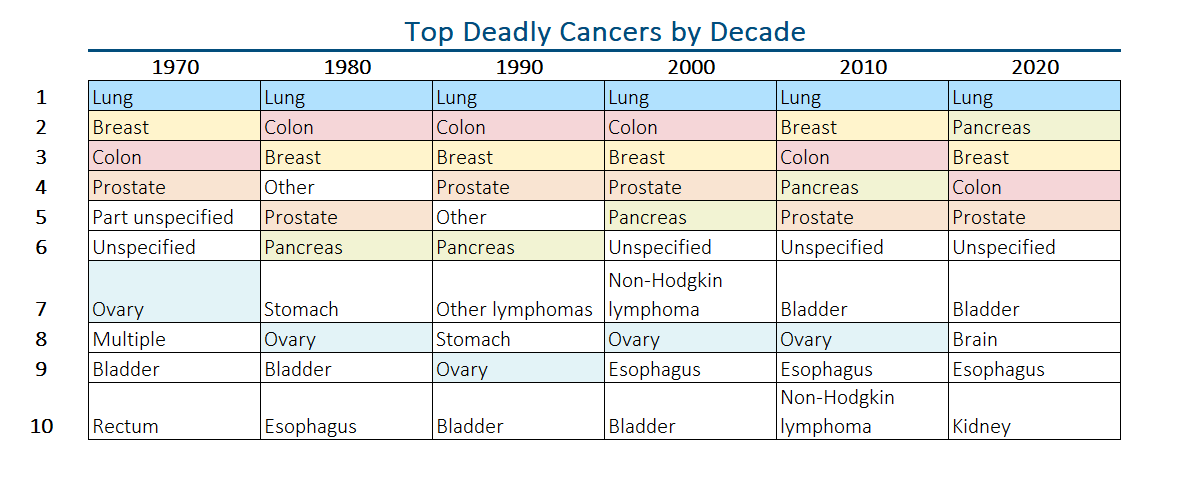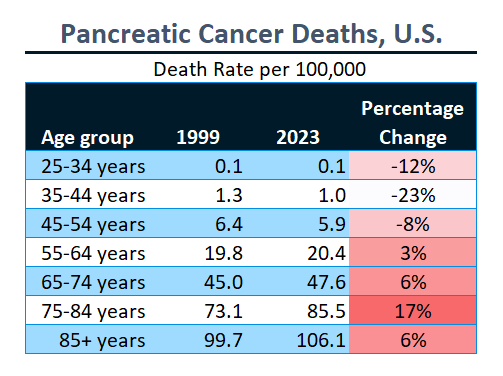Pancreatic Cancer Trends: 1999-2023, U.S.
Plus: Best wishes to Rep. Sheila Jackson Lee
This hasn’t made as big a news splash because of all the other things going on (also, scanty details), but I noticed Sheila Jackson Lee announced a diagnosis of pancreatic cancer:
AP: Rep. Sheila Jackson Lee, a Texas Democrat, says she has pancreatic cancer
Longtime U.S. Rep. Sheila Jackson Lee announced that she has been diagnosed with pancreatic cancer and is undergoing treatment.
The 74-year-old Texas Democrat, who is seeking a 16th term, said in a statement late Sunday that as a member of Congress, she has been honored to be a leader in the fight for justice and equality and will approach this more personal fight with faith and courage.
“I am confident that my doctors have developed the best possible plan to target my specific disease,” Jackson Lee said. “The road ahead will not be easy, but I stand in faith that God will strengthen me.”
Given that’s the level of information she has disclosed, I will make no remarks about her condition. I wish her the best. Cancer treatment can be difficult.
That said, her news reminded me that pancreatic cancer was one of the cancer types I wanted to revisit, given that many of the others have shown good trends since 1999:
But not pancreatic cancer. On an age-adjusted death rate basis, it has steadily risen.
As many of the other cancer types have had falling death rates, pancreatic cancer has marched up the ranks:
Pancreatic Cancer by Age Group
To keep it simple, I will keep my investigation to 1999-2023 (because I get to keep to ICD-10 codes).
Also, I get to use my recent spreadsheet (huzzah! I get to reuse something!)
I’ll use the simplified age groups for visualization purposes. Essentially, there are minimal deaths due to pancreatic cancer under the age of 25, so we don’t even have to consider that age group.
Death Counts
This shows death counts, so as the population has been aging, it’s not necessarily surprising that deaths have increased. This has occurred with many natural causes of death.
Death Rates
Remember to ignore the bogus cancer death rate spike for age 85+ in 2021 (due to faulty population estimates), but it is difficult to see what the actual trends are, due to the very different levels of rate.
Summary results for age
So let me do something different, and provide a table of more detailed age groups and just the beginning and ending death rates:
There does seem to be a dichotomy here: at the younger ages, which already started with lower pancreatic cancer death rates, the rates decreased over 1999-2023.
If one actually looks at the “lines” (such as they are) for those aged under 45, there is a lot of noise due to the relative rarity of this cause of death for young adults.
For middle-aged adults and the oldest seniors, their rates slightly increased over the 24 years.
But for those aged 75-85 years old, the 17% increase is substantial.
The reason pancreatic cancer death rates have exceeded that of other cancer types (other than lung) is that the others had generally decreasing rates at most ages. Not so for pancreatic cancer.
Other quick demographic slices: sex, race/ethnicity
I did a quick look at differences by sex — the trend by sex was the same (both increased 7 - 8% in age-adjusted death rate from 1999-2023).
There was an interesting trend by race/ethnicity. Not all groupings had sufficient deaths to calculate age-adjusted death rates, so I picked what I could.
So, interestingly, both Hispanic and Non-Hispanic White groups showed relatively large increases in death rates due to pancreatic cancer, while Non-Hispanic Asian showed a mostly flat pattern, with Non-Hispanic Black showing a slight improvement.











